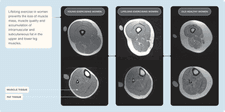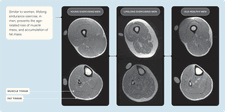
Zone 2 Endurance Training and Its Relationship With Longevity, Cardiovascular, and Musculoskeletal Health
For a decade, high-intensity interval training (HIIT) has dominated the fitness world, thanks to its touted ability to enhance health and performance. Recent advances have begun to explore the impact of much slower endurance-based training on metabolic health and potentially longevity. We will deep dive into this training practice to discuss how to incorporate this into your daily life and what's going on at the cellular, molecular & whole-body level when you train in zone 2 & 5. Lastly, we'll look at how these training modalities impact longevity, reduced risk of all-cause mortality, and the benefits of maintaining endurance exercise your entire life.
Exercise
fitness
14 mins
By: Dr Ryan N. Marshall, PhD.
Overview
Short bursts of high-intensity interval-type training have been a popular method of cardiovascular exercise for the last ten years. Since a series of popular, published papers, and even a book, "The One Minute Workout" from Professor Martin Gibala, at McMaster University Canada, there was a rise in these short, high-effort based training to improve health & performance in the everyday athlete [1]. However, frequent training at such a high-intensity interval training multiple times per week may result in an accumulation of excessive metabolic stress and potential impairments in health & performance [2].
Recent advances have begun to explore the impact of much slower endurance-based training on metabolic health and potentially longevity. In particular, Dr Peter Attia has been a strong advocate of the 80:20 principle, by which individuals should spend 80% of their weekly training volume in easy, low-intensity (Zone 2), with only 20% of their training at high-effort, high-intensity (Zone 5).
In this article, we will deep dive into this training practice to discuss how to incorporate this into your daily life and what's going on at the cellular, molecular & whole-body level when you train in zone 2 & 5. Lastly, we'll look at how these training modalities impact longevity, reduced risk of all-cause mortality, and the benefits of maintaining endurance exercise your entire life.
What Are Training Zones & Where Should You Be Training?
Based on heart rate zones, there are five training zones to train within.
Zone 1: 50-60% Maximal Heart Rate
Zone 2: 60-70% Maximal Heart Rate
Zone 3: 70-80% Maximal Heart Rate
Zone 4: 80-90% Maximal Heart Rate
Zone 5: 90-100% Maximal Heart Rat
Training programs for athletes and everyday athletes are typically structured based on different training zones, intensities, and workouts, distributed over a week or training block, often referred to as micro-cycles and macro-cycles.
While training across all zones is essential, zone 2 training holds particular importance in improving cardiovascular performance and aerobic capacity. Regrettably, athletes and everyday athletes frequently overlook or receive inadequate zone 2 training in favor of multiple sessions of HIIT per week, resulting in a suboptimal development of their aerobic base.
Erroneously, some athletes and members of the public believe that consistently training at high intensities is the sole path to improved performance and health. However, this approach fails to harness the potential benefits that extensive zone 2 training can offer and the potential pitfalls of chronic and repeated bouts of HIIT.
Emphasizing zone 2 training in significant volumes is vital for individuals to maximize their physiological adaptations and enhance their overall performance, longevity, and lifespan.
Dr Peter Attia, and several other prominent researchers, in particular Professor Stephen Seiler, a world-leading sports scientist, and professor at The University of Agder, Norway, have popularised the 80:20 rule of endurance training (also commonly referred to as 'polarised training'), not only for improving exercise performance but also longevity.
Notably, Professor Seiler has recorded a Ted Talk titled "How 'normal people' can train like the world's best endurance athletes", which now has >1.5 million views on YouTube. In his research and talks on the topic, he typically gives examples of the training characteristics of world-class distance runners.
A recent 2022 update on this literature has shown that world-leading track & marathon runners spend >80% of their training volume within the easy aerobic zone 2 [3]. Notably, as training intensity is relative to each individual, this makes training like an athlete possible to everyday athletes.
Zone 2 Training: How do you find your training zones outside of the lab?
The gold standard measurement to determine your training zones would be to complete a VO2 max test under the supervision of a certified exercise physiologist or cardiovascular physician. Within this test, breath-by-breath analysis is collected to determine your oxygen consumption per minute, as well as blood sampling to determine your lactate threshold following a graded exercise test in which the speed of the treadmill or the power on the cycle ergometer gets incrementally harder every ~3 minutes.
This sort of test will be able to determine the exact HR, power output, lactate concentration, and running pace for each training zone. However, these comprehensive tests often require state-of-the-art equipment, and highly-trained staff, cost hundreds of dollars per test, and need repeating at the end of every training cycle to ensure you are training at the required intensity/workload. The Sports Medicine Clinic at the University of California Davis covers a wide range of physiological tests to precisely determine optimal training zones & intensities). However, even with these tests, there is still a disagreement between research scientists as to what the true definition of Zone 2 is.
In an attempt to make training zones more economically viable for the everyday trainer, other methods are typically used to estimate this outside of the lab. There are specific formulas which can be used to roughly estimate the required heart rate needed to be in zone 2. Perhaps the most accurate method is the Tanaka equation (Hear Rate Max = 208 – (0.7 x Age) [4].
If this is not accurate enough, individuals have the ability to buy a fingertip lactate meter on Amazon for ~£350/$430. With this tool, individuals can monitor their blood lactate during training, which, when combined with an estimation of HR max, may give you a good indication of your training zone. Maintaining a blood lactate of between 1.0-2.0 mmol/L, which should feel relatively easy, with a perceived exertion of between 3-4 out of 10 (10 being maximal exertion/effort), is a good indicator of training in zone 2.
How long should you train in this zone?
Elite athletes will be training in this zone for 80% of their training week, which could result in sessions between 2-5 hours long. However, for the everyday athlete, and those looking to improve their longevity & metabolic health, we recommend significantly lower durations. Specifically, durations of 1-2 hours are sufficient to induce adaptative responses within skeletal muscle and other tissues, which we will discuss below.
Should I be incorporating high-intensity exercise (Zone 5)?
Peter Attia recently recorded a podcast with Dr Iñigo San-Millán, PhD., an Assistant Professor at The University of Colorado's Medical School and the team performance director for the world-leading cycling team UAE Team Emirates. In this podcast, they went into detail regarding zone 2 training and touched upon the importance of zone 5 training and stressing the cardiovascular system once per week.
In this, Peter mentions his protocol of 4x4x4 minutes in zone 5, in which 4 minutes is completed in zone 5, followed by 4 minutes of rest, and repeated four times. As mentioned previously, HIIT has become ever-present in the fitness industry and is hailed as the ultimate training method to get fit, healthy, and burn fat. Although this is somewhat true, completing multiple HIIT sessions per week for a prolonged period of time can have detrimental effects to metabolic health [2].
In a somewhat provocative publication in Cell Metabolism, a team from The Swedish School of Sport and Health Sciences led by PhD graduate Dr. Mikael Flockhart, showed that 4-weeks of HIIT induced a 10% decrease in glycaemic control and a 40% reduction in dysfunction, which resulted in a decline in exercise performance [2].
Interestingly, not all research groups have observed this phenomenon. Research from Professor David Bishop's group at Victoria University, Melbourne, Australia, has observed the opposite and reported improvements in exercise performance & metabolic function [5]. In particular, Professor Bishop's group observed a 50% increase in mitochondrial content and a >40% increase in mitochondrial function [5].
An interesting discrepancy between the studies is the methods of analysis & normalization of the mitochondrial data. Notably, the publication from Mikael utilized isolated mitochondria from skeletal muscle biopsy samples [2], with Professor Bishop's group using permeabilized muscle fibers [5]. Therefore, when interpreting scientific research, it is important to evaluate the physiological relevance of the data and how this may impact your training.
What Are the Cellular and Molecular Effects of Zone 2 Training?
There are a myriad of molecular signals and adaptive responses following any type of exercise. However, here we will focus on the adaptive response to mitochondrial health and the capillarization of skeletal muscle.
Mitochondrial Content & Function
Training for 60-120 minutes in a comfortable zone 2 training intensity can have significant improvements in mitochondrial health, notably increasing mitochondrial content (i.e., the number or size of mitochondria), and the efficiency of mitochondrial energetics (i.e., greater ability to convert glucose and lipids into fuel).
Utilizing stable isotope tracer methods, early work from Professor Stu Phillips' Lab at McMaster University showed a >150% increase in mitochondrial protein synthesis following 45 minutes at an intensity of 75% VO2 peak [6].
What is interesting is that often anti-aging & longevity drugs are taken alongside undertaking an exercise training program and can often have unwarranted side effects of blunting the beneficial response to exercise. For example, work from Professor Charlotte Peterson's Center for muscle biology at the University of Kentucky has observed blunting in muscle hypertrophy, muscle strength, and molecular gene signaling in older adults taking 1,700mg of Metformin daily [7]. Rapamycin, however, does not suffer from this problem [8].
Published work from Dr. Andrew Philp showed rapamycin did not blunt the muscle protein synthetic response following a session of endurance exercise, even when mTOR was blunted [8].
Mitochondrial content & size is also improved following as little as 6 weeks of zone 2 training [9]. A 2018 paper published by the lab of Professor Carsten Lundby from the Zürich Center for Integrative Human Physiology at the University of Zürich in Switzerland showed 4 weekly sessions of 60 minutes in zone 2 increased mitochondrial size by 55% (assessed via high-resolution transmission electron microscopy), with a concurrent 44% increase in citrate synthase activity [9].

Mitochondrial Size
What is interesting is that contrary to previous hypotheses of an increase in mitochondrial biogenesis (i.e., the formation of new mitochondria), is that the surface area and density of mitochondria are improved following endurance exercise [9].
An important caveat when measuring mitochondrial content within skeletal muscle is the method used [10]. Transmission electron microscopy is the 'gold standard' and the best way to determine mitochondrial number, size, density, and location [10]. However, other methods can be used to determine the efficiency of these mitochondria by determining how much oxygen they consume in response to certain substrates.
A common technique is to use high-resolution respirometry. In a 2018 publication in Aging Cell, Dr Adam Konopka, PhD., presented the beneficial effects of aerobic endurance training in older adults, showing it's not too late to start exercising over the age of 60 [11].
Dr Konopka and his group showed 12 weeks of endurance training (3 sessions per week, 45-minute duration) increased VO2 max, which was underpinned by improvements in mitochondrial function [11]. Notably, following the 12 weeks of endurance exercise, skeletal muscle mitochondria developed better fatty acid oxidation and improved ADP sensitivity.
Endurance exercise training also increased the P/E ratio, which dictates an increased OXPHOS capacity (i.e., coupled respiration) and overall improved intrinsic mitochondrial health [11].
Capillary Density
One of the characteristics of aging is a reduction in capillary density within tissues, leading to reduced blood flow and, thereby, the delivery of oxygen and nutrients to support cellular and tissue health.
Notably, muscle capillary density is ~24% lower in older adults compared to younger adults [12], which has been correlated to reduced maximal oxygen consumption during exercise [13], post-meal insulin sensitivity [14], and blunted hypertrophic response to exercise [15]. Endurance-trained individuals display superior capillary density compared to age-matched untrained [16]. In particular, they display >50% more capillaries per muscle fiber, which were predominantly around type I muscle fibers (i.e., slow twitch/endurance-type muscle fibers) [16].

Mitochondrial Density with Zone 2 Exercise

Type 1 Muscle Fiber from Zone 2 Exercise
Zone 2 Training, VO2 Max, and Its Relationship with All-Cause Mortality
Maximum oxygen consumption (VO2 max) is not only an indicator of endurance exercise performance but also a strong predictor of cardiovascular disease and mortality. In fact, cardiorespiratory fitness is the single greatest predictor of health and functional capacity.
High cardiorespiratory fitness has been observed to reduce the risk of developing coronary artery disease, hypertension, diabetes, stroke, and cancer. A recent publication in the Journal of American Medical Association recently tested the largest cohort to date of >120,000 individuals over 8 years, which showed those with a low cardiorespiratory fitness showed ~20% lower survival probability compared to those with high levels of fitness [17].
"The simple definition of "all-cause mortality" is the measure of the overall risk of death from any cause within a specified population or group. It represents the likelihood of individuals in that population dying from various factors, including diseases, accidents, violence, or any other cause of death."
In extensive multi-center studies comparing >120,000 individuals of varying fitness levels, the major statistical test used is termed hazard ratios. A hazard ratio of 1 indicates no difference in the risk of the event between the two groups. A hazard ratio greater than 1 indicates an increased risk in the group being compared, while a hazard ratio less than 1 indicates a decreased risk in the same group.
When we compare low cardiorespiratory fitness with high- cardiorespiratory fitness, the hazard ratio is 3.9! This means there's a 290% greater chance of dying by all-cause mortality [17]. This is further increased to a hazard ratio of 5 (or 400%) when compared to elite cardiorespiratory health, showing no observed upper limit to fitness status.
Overall, this publication highlights the importance of cardiorespiratory fitness and that this is a completely modifiable indicator of health & longevity [17]. Therefore, undertaking multiple weekly sessions of aerobic zone 2 training will likely pay dividends in years to come and prolong your cardiorespiratory health, metabolic flexibility, and overall lifespan.
What Are the Benefits of Lifelong Exercise on Metabolic Health?
Studying the effects of lifelong endurance exercise is an incredibly hard topic of research to undertake, primarily due to its niche population [18]. The pool of older adults who have maintained high levels of exercise and still train, race, and compete in competitive events is tiny!
However, a few research groups around the world have published evidence on the benefits of lifelong exercise on cardiovascular [19], musculoskeletal [20], and brain health [21]. Below we will briefly discuss how lifelong exercise can prevent traditional age-related decline and, in some cases, display similar physiological and metabolic characteristics to that of individuals <40 years younger, overall showing the importance of maintaining adequate amounts of endurance exercise across the lifespan.
Research fromProfessor Scott Trappe's research group from the Human Performance Laboratory at Ball State University has published several high-profile scientific articles characterizing the biological characteristics of highly active lifelong endurance athletes [19], [22–24].
Professor Trappe has consistently observed greater metabolic, cardiovascular, and musculoskeletal health compared to 'normal' older adults and, in some cases, display similar physiological profiles to that of younger individuals.
Notably, as leg muscle mass is a key predictor of sarcopenia, frailty, and quality of life, he showed in his 2020 publication in the Journal of Applied Physiology that individuals who have participated in lifelong exercise display minimal loss of quadriceps, and when compared to 'normal' healthy older adults, an attenuated decline of ~50% is observed [25].
Another key indicator of muscle health is the amount of fat that has infiltrated into skeletal muscle (termed 'intramuscular fat'). In the same study, Professor Trappe's group observed significantly less (~30%) intramuscular fat in lifelong exercisers compared to 'normal' older adults [25].

Zone 2 Exercise and Muscle Composition in Women

Zone 2 Exercise and Muscle Composition in Men
Maintaining lifelong endurance exercise has also been shown to maintain mitochondrial health into later life. Research from the University of Copenhagen's department for cell biology & physiology showed that highly trained 60-70 years old men had >100% more mitochondria, and their function were significantly better than age-matched untrained older adults and even better than younger adults [26].
More sophisticated proteomic investigations of 15 octogenarian world-class track and field MAs and 14 age-matched non-athlete's showed significantly greater VO2 max, as well as muscle strength & mass [27].
The research from Professor Russell Hepple's lab at the University of Florida showed 176 mitochondrial proteins were elevated in the >80 year old master athletes, owing to greater mitochondrial quality control (i.e., OPA1, MFN-2) [27]. As previously mentioned in the article, aging results in a decline in muscle capillary density. Research from Dr. James McKendry showed that individuals that had maintained lifelong endurance exercise had >35% more capillaries per fiber than both younger and older adults [28].
TAKE HOME POINTS
Zone 2 training is essential for optimal cardiovascular and cardiorespiratory fitness.
The combination of Zone 2 & Zone 5 training is likely optimal for developing superior performance and adaptive responses.
VO2 max & cardiorespiratory health is the single greatest predictor of health & longevity. Improving this value will likely add quality years to your life.
Zone 2 endurance training induces significant improvements in mitochondrial content, function, and substrate utilization.
Capillary density is an often overlook physiological mechanism. Improving the number of capillaries per muscle fiber will drastically improve oxygen delivery, insulin sensitivity, and mitochondrial/oxidative metabolism.
It's never too late to start exercising. Even older adults can see drastic improvements in body composition and metabolic health with zone 2 endurance exercise.
Maintaining exercise your entire life is the optimal way to age. Lifelong exercisers and master athletes display remarkable levels of lean mass, minimal body fat, and their physical and metabolic function is similar to that of individuals <30 years younger.
Citations
Latest Longevity Research Straight to your Inbox
Sign up for The Longevity Blueprint, a weekly newsletter from Healthspan analyzing the latest longevity research.





